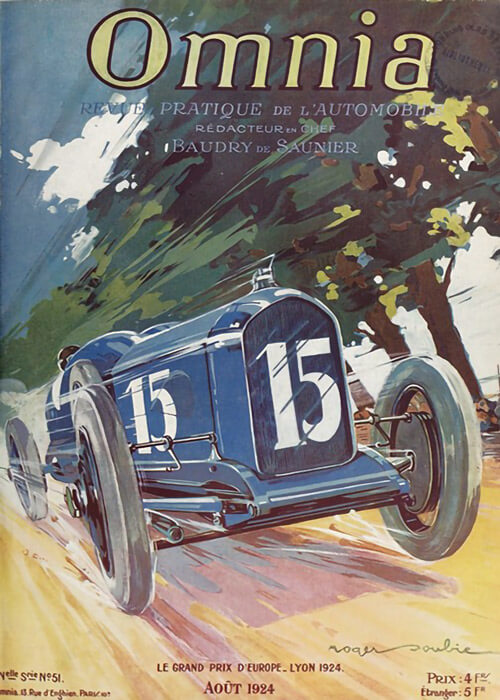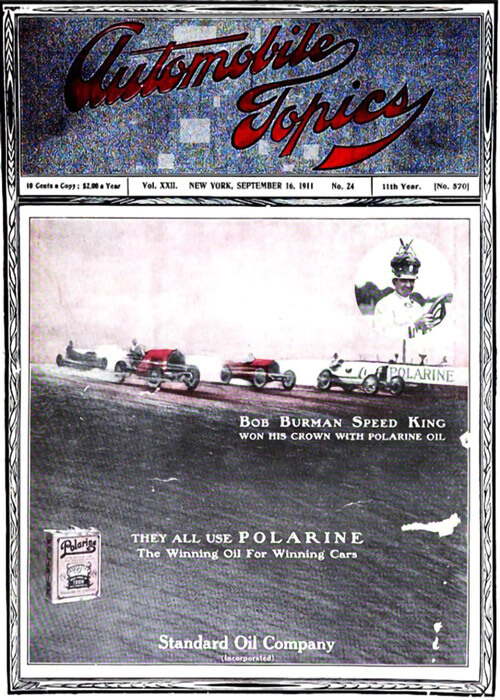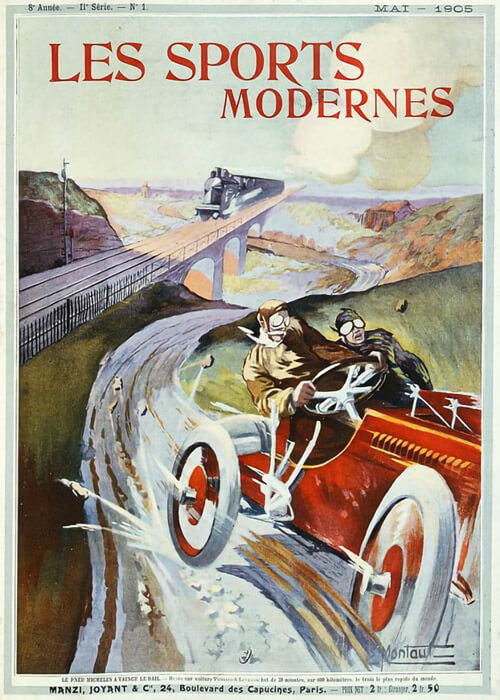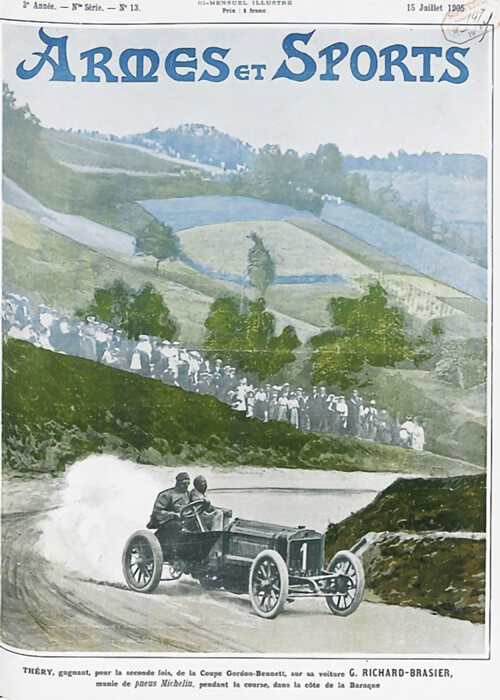The detachable wheel rims are described here. Additionally, Louis Renault, the car deisgner and Ferenc (or Francois) Szisz the race driver are given many credits for their work; despite a poor evaluation of the Grand Prix race.
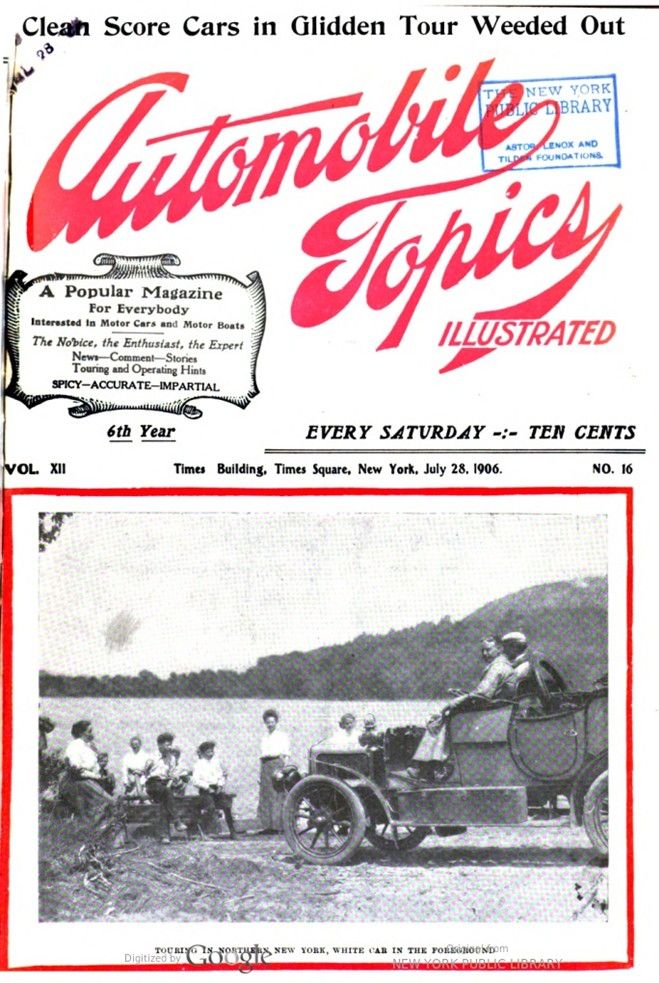
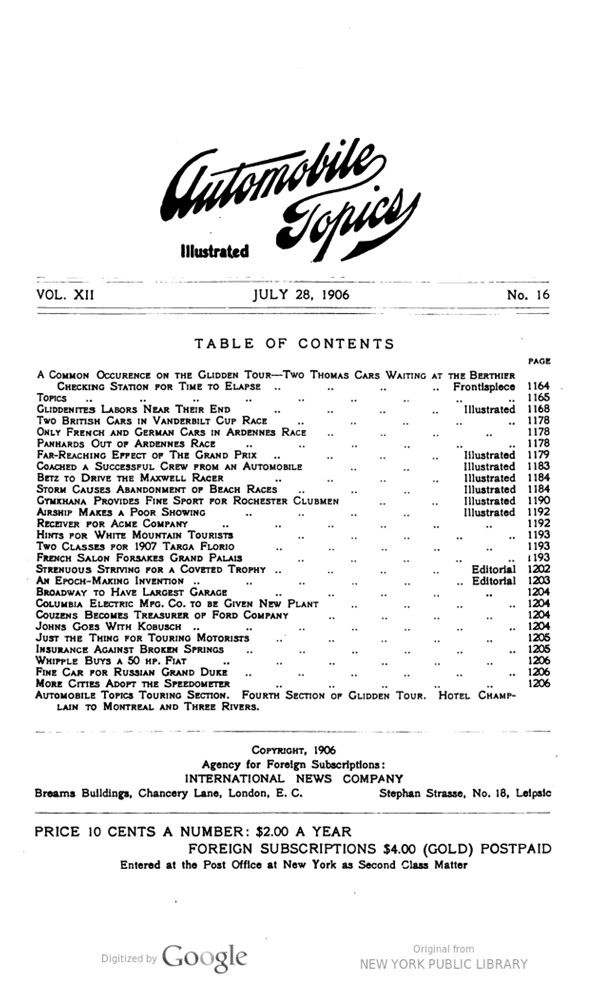
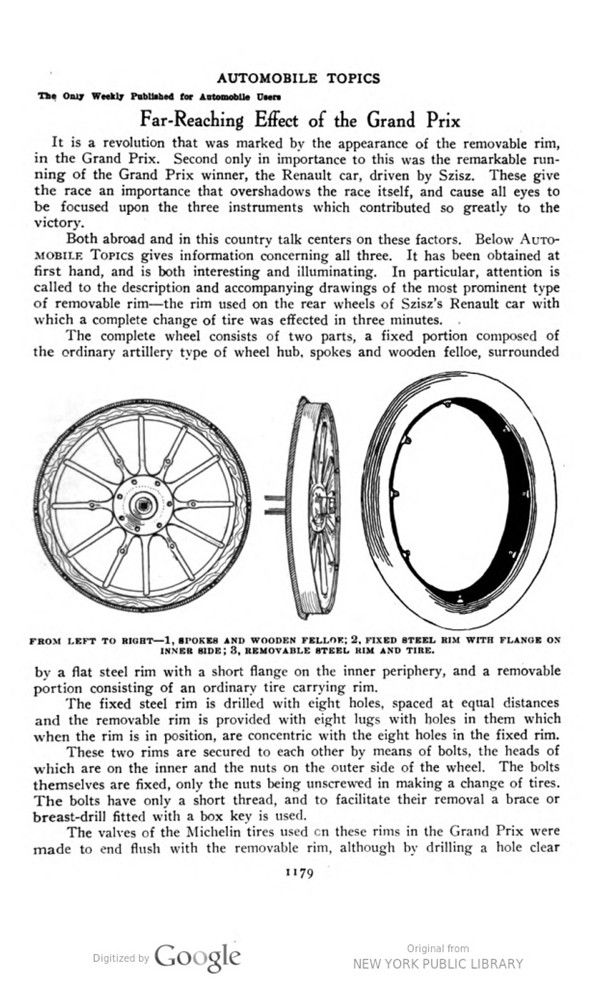

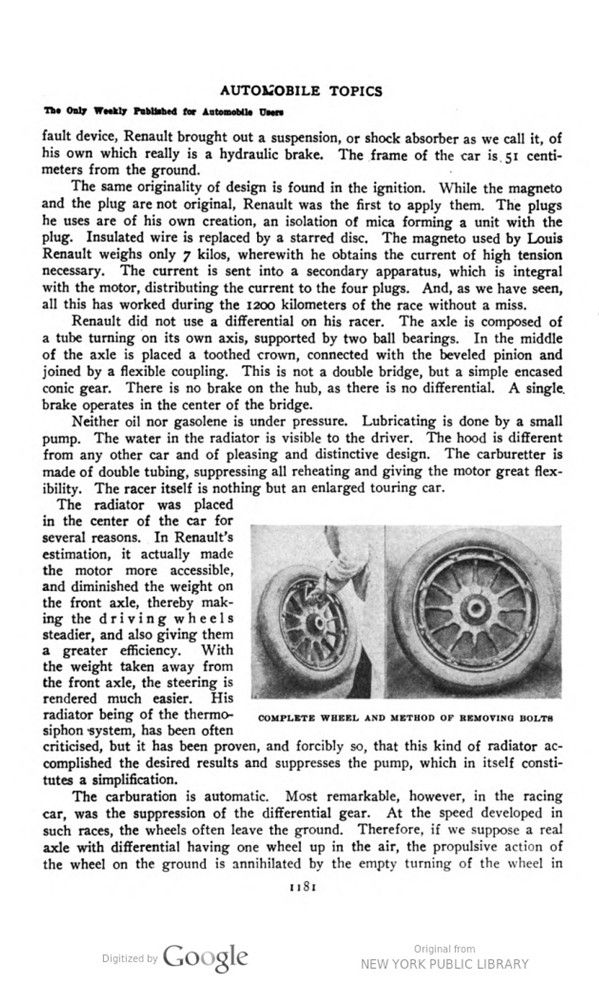
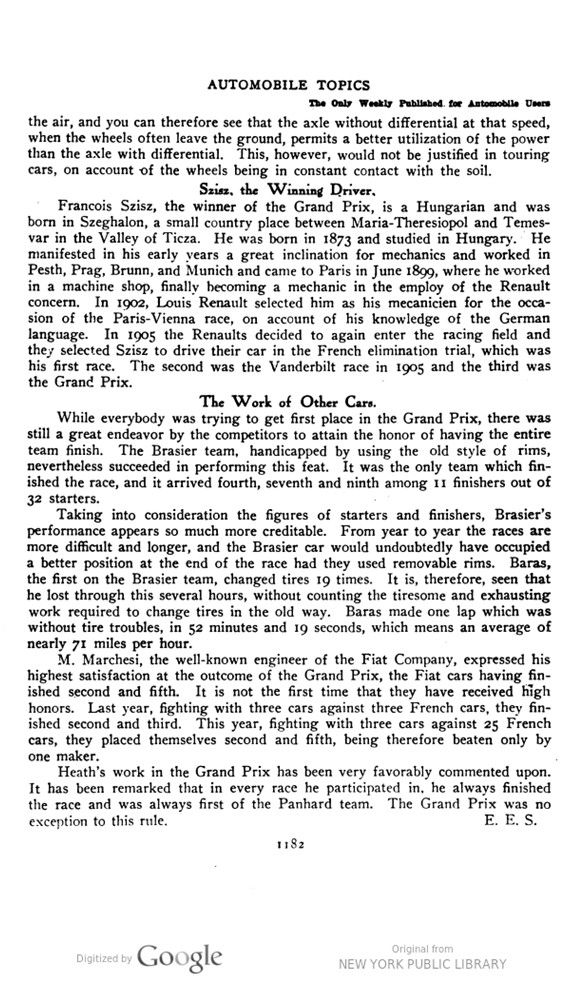
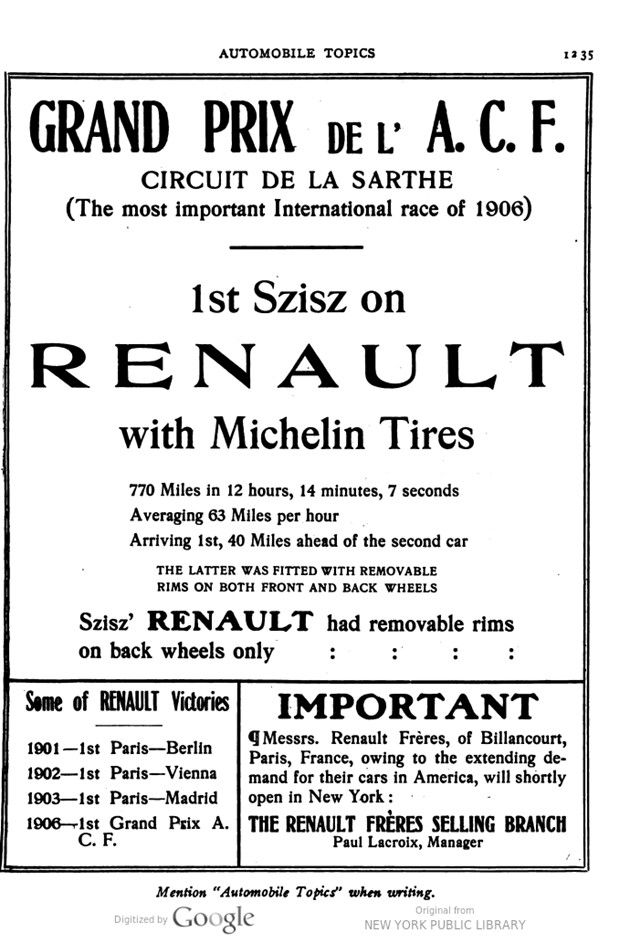
Text and jpegs by courtesy of hathitrust.org www.hathitrust.org, compiled by motorracinghistory.com
Automobile Topics, Vol. 12, No. 16, July 28, 1906, page 1179-1182
Far-Reaching Effect of the Grand Prix
It is a revolution that was marked by the appearance of the removable rim, in the Grand Prix. Second only in importance to this was the remarkable running of the Grand Prix winner, the Renault car, driven by Szisz. These give the race an importance that overshadows the race itself and cause all eyes to be focused upon the three instruments which contributed so greatly to the victory.
Both abroad and in this country talk centers on these factors. Below AUTOMOBILE TOPICS gives information concerning all three. It has been obtained at first hand and is both interesting and illuminating. In particular, attention is called to the description and accompanying drawings of the most prominent type of removable rim – the rim used on the rear wheels of Szisz’s Renault car with which a complete change of tire was effected in three minutes.
The complete wheel consists of two parts, a fixed portion composed of the ordinary artillery type of wheel hub, spokes and wooden felloe, surrounded by a flat steel rim with a short flange on the inner periphery, and a removable portion consisting of an ordinary tire carrying rim.
The fixed steel rim is drilled with eight holes, spaced at equal distances and the removable rim is provided with eight lugs with holes in them which when the rim is in position, are concentric with the eight holes in the fixed rim.
These two rims are secured to each other by means of bolts, the heads of which are on the inner and the nuts on the outer side of the wheel. The bolts themselves are fixed, only the nuts being unscrewed in making a change of tires. The bolts have only a short thread, and to facilitate their removal a brace or breast-drill fitted with a box key is used.
The valves of the Michelin tires used on these rims in the Grand Prix were made to end flush with the removable rim, although by drilling a hole clear through the rim and the felloe an ordinary tire valve can be used, the only objection being the loss of time necessary to carefully push it into its proper position.
Spare tires are carried fully inflated on the removable rims, and in case of puncture or blowout the car is jacked up, the eight nuts removed, and the tire and rim slipped off. The new tire, with its rim, is then slipped into place, the nuts screwed home and the jack knocked down. The whole operation, with only two men, taking from 3 to 4 minutes.
The Renault Car and its Designer
Louis Renault, the engineer who designed and built the winning Renault car, was born in Paris, Feb. 12, 1877. His age, therefore, is 29 years. He is the youngest automobile engineer in the world. When he built his first vehicle which won a race, he was only 22 years old.
In school young Renault was not regarded as a very brilliant scholar. The son of a woollen merchant, with no inclination for the counting house, he was looking around to get a position in the mechanical world and entered the house. of Delaunay-Belleville before they built any automobiles. This was in 1896, but the automobile had a great attraction for Renault, and he applied to Levassor of the house of Panhard Levassor, for a position as designer. Levassor turned him down under pretext that they did not want any amateurs! Not discouraged, Renault obtained from his mother, permission to establish a small shop for his experiments, and after having designed several motors, he started the construction of a car which was entirely on new lines.
With this car, which had as its distinguishing feature the direct drive in- vented by Renault in 1899, and which was termed a voiturette, he won the Paris- Rambouillet, Paris-Trouville and Paris-Ostende races. It is interesting to recall that this voiturette had 2 3/4 hp. De Drou motor!
Louis Renault was always original and disdained to copy other makers. He followed his own plans and developed them gradually from year to year. His car is from one end to the other his own creation and conception. Examining his latest car, the Grand Prix winner, you will find the radiator, which in nearly all cars is placed in front, is located right in the center of the chassis, thereby relieving the front part of the vehicle of much of its usual heavy load.
The radiator itself is not an ordinary radiator, either. This is also one of his creations. It is a simple condenser, in which the air circulates around all the tubes which are without flanges. He was the first to use the shaft drive, at a time when others used the chain. He has been fighting since 1899 to 1902 against the old established makers. The frame of his car is also different from all others. It is only 1 meter and 9 centimeter wide. The suspension is likewise different. While everybody else is using the well known and meritorious Truffault device, Renault brought out a suspension, or shock absorber as we call it, of his own which really is a hydraulic brake. The frame of the car is 51 centimeters from the ground.
The same originality of design is found in the ignition. While the magneto and the plug are not original, Renault was the first to apply them. The plugs he uses are of his own creation, an isolation of mica forming a unit with the plug. Insulated wire is replaced by a starred disc. The magneto used by Louis Renault weighs only 7 kilos, wherewith he obtains the current of high tension necessary. The current is sent into a secondary apparatus, which is integral with the motor, distributing the current to the four plugs. And, as we have seen, all this has worked during the 1200 kilometers of the race without a miss.
Renault did not use a differential on his racer. The axle is composed of a tube turning on its own axis, supported by two ball bearings. In the middle of the axle is placed a toothed crown, connected with the beveled pinion and joined by a flexible coupling. This is not a double bridge, but a simple encased conic gear. There is no brake on the hub, as there is no differential. A single. brake operates in the center of the bridge.
Neither oil nor gasolene is under pressure. Lubricating is done by a small pump. The water in the radiator is visible to the driver. The hood is different from any other car and of pleasing and distinctive design. The carburetter is made of double tubing, suppressing all reheating and giving the motor great flexibility. The racer itself is nothing but an enlarged touring car.
The radiator was placed in the center of the car for several reasons. In Renault’s estimation, it actually made the motor more accessible, and diminished the weight on the front axle, thereby making the driving wheels steadier, and also giving them a greater efficiency. With the weight taken away from the front axle, the steering is rendered much easier. His radiator being of the thermo-siphon system, has been often criticised, but it has been proven, and forcibly so, that this kind of radiator accomplished the desired results and suppresses the pump, which in itself constitutes a simplification.
The carburation is automatic. Most remarkable, however, in the racing car, was the suppression of the differential gear. At the speed developed in such races, the wheels often leave the ground. Therefore, if we suppose a real axle with differential having one wheel up in the air, the propulsive action of the wheel on the ground is annihilated by the empty turning of the wheel in the air, and you can therefore see that the axle without differential at that speed, when the wheels often leave the ground, permits a better utilization of the power than the axle with differential. This, however, would not be justified in touring. cars, on account of the wheels being in constant contact with the soil.
Szisz, the Winning Driver.
Francois Szisz, the winner of the Grand Prix, is a Hungarian and was born in Szeghalon, a small country place between Maria-Theresiopol and Temes- var in the Valley of Ticza. He was born in 1873 and studied in Hungary. He manifested in his early years a great inclination for mechanics and worked in Pesth, Prag, Brunn, and Munich and came to Paris in June 1899, where he worked in a machine shop, finally becoming a mechanic in the employ of the Renault concern. In 1902, Louis Renault selected him as his mecanicien for the occasion of the Paris-Vienna race, on account of his knowledge of the German language. In 1905 the Renaults decided to again enter the racing field and they selected Szisz to drive their car in the French elimination trial, which was his first race. The second was the Vanderbilt race in 1905 and the third was the Grand Prix.
The Work of Other Cars.
While everybody was trying to get first place in the Grand Prix, there was still a great endeavor by the competitors to attain the honor of having the entire team finish. The Brasier team, handicapped by using the old style of rims, nevertheless succeeded in performing this feat. It was the only team which finished the race, and it arrived fourth, seventh and ninth among 11 finishers out of 32 starters.
Taking into consideration the figures of starters and finishers, Brasier’s performance appears so much more creditable. From year to year the races are more difficult and longer, and the Brasier car would undoubtedly have occupied a better position at the end of the race had they used removable rims. Baras, the first on the Brasier team, changed tires 19 times. It is, therefore, seen that he lost through this several hours, without counting the tiresome and exhausting work required to change tires in the old way. Baras made one lap which was without tire troubles, in 52 minutes and 19 seconds, which means an average of nearly 71 miles per hour.
M. Marchesi, the well-known engineer of the Fiat Company, expressed his highest satisfaction at the outcome of the Grand Prix, the Fiat cars having finished second and fifth. It is not the first time that they have received high honors. Last year, fighting with three cars against three French cars, they finished second and third. This year, fighting with three cars against 25 French cars, they placed themselves second and fifth, being therefore beaten only by one maker.
Heath’s work in the Grand Prix has been very favorably commented upon. It has been remarked that in every race he participated in, he always finished the race and was always first of the Panhard team. The Grand Prix was no exception to this rule.
E. E. S. (E.E. Schwarzkopf, President Automobile Topics)

